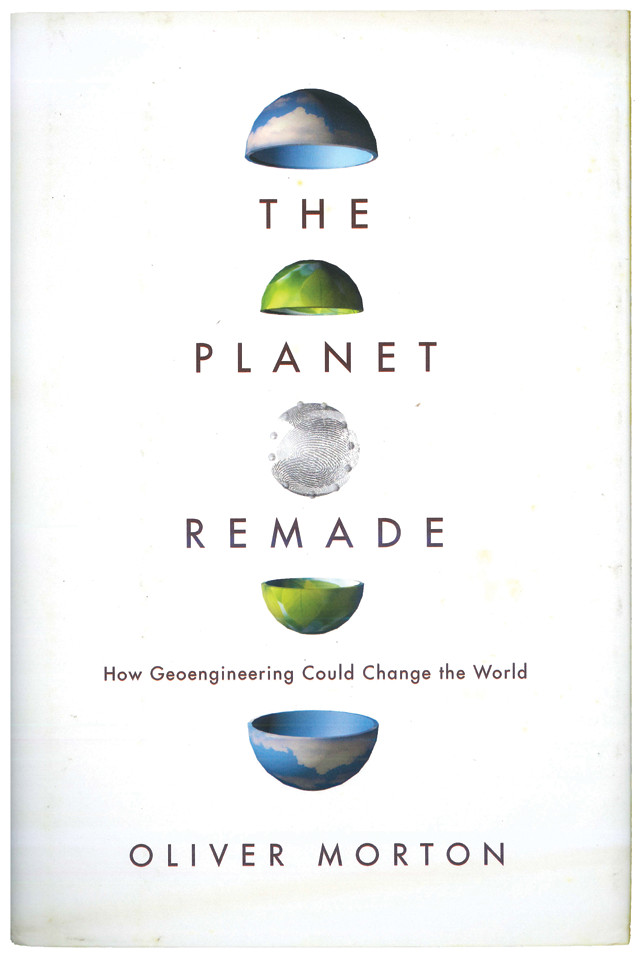
by Callan Bentley Thursday, May 18, 2017

"The Planet Remade: How Geoengineering Could Change the World," Oliver Morton, Princeton University Press, 2015, ISBN-13: 978-0691148250, Paperback, 2017, ISBN-13: 978-0691175904.
Geoengineering, the deliberate large-scale modification of environmental processes on Earth, is often proffered as a solution to climate change. The transfer of carbon long sequestered in geologic repositories to the atmosphere has raised greenhouse gases to levels unprecedented in the history of our species. As a result, the average surface temperature and the heat content of the oceans have both increased.
So what do we do? We have several options: We can attempt to curb our carbon dioxide emissions (mitigation); capture carbon dioxide from the air and stick it back underground (sequestration); adapt our ways of living to deal with the new reality’s many manifestations (adaptation); or, do nothing.
Geoengineering offers a suite of other options: for example, lowering the amount of solar energy entering the Earth system; encouraging the growth, death and burial of carbon-sequestering marine plankton; and grinding up rocks to react with and draw down atmospheric carbon dioxide or buffer the ocean against acidification.
Journalist Oliver Morton has thought through the implications of these options, immersing himself in the detailed technical aspects of geoengineering for more than a decade. The result is “The Planet Remade: How Geoengineering Could Change the World,” the most comprehensive and readable popular account of geoengineering currently available. The content is well-informed and articulate; the prose is imaginative and poetic.
Morton’s take on the mind-blowing, society-altering implications of geoengineering is sobering at times, and giddy at others. After all, assuming command at the helm of Spaceship Earth and ordering a drastic change in course is no small undertaking. Of course, our planet has no control panel or steering wheel. Morton instead invokes levers as his chosen analogy. Before pulling any levers, however, Morton suggests we need to study Earth more to identify things we’re actually capable of changing, in ways that will actually counteract warming.
An excellent section of the book explores human alteration of the nitrogen cycle as an example of geoengineering past and present (although it is called by another name). In 1913, when Fritz Haber and Carl Bosch industrialized nitrogen fixation (reacting molecular nitrogen with hydrogen to make ammonia), they set in motion a system of transferring Earth’s most abundant atmospheric gas into our soils, thereby boosting crop production to unprecedented levels and allowing the human population to quadruple. Today, that artificial process fixes more nitrogen than all the nitrogen-fixing bacteria on Earth. Humans have intentionally manipulated and exceeded nature’s capacity for moving an element from one Earth reservoir to another. Anthropogenic nitrogen fertilizer has negative side effects as well, but decreasing famine is surely something to be celebrated.
Another section focuses on a hypothetical campaign to spray sulfate aerosols into the stratosphere from aircraft. He details how he imagines such a scheme could work, and the political ramifications if some nations or companies started flying these aircraft without waiting for the rest of the world to get on board with the plan. His description is so vivid that I started to think such a scenario could be plausible, perhaps even inevitable. Morton’s thinking on the topic has yielded some unexpected insights: For instance, in a footnote he points out that even if we don’t engage in geoengineering, it will still be relevant. If the sulfate-distributing technology is even rumored to exist, unusual weather events might be attributed to its clandestine use by rogue states or conspirators.
Is it audacious to contemplate geoengineering? Or is it stupid not to? Many people resist the notion out of a justifiable fear of inadvertently upsetting the system that sustains our lives, or based on knee-jerk rejections against approaches they consider “unnatural.” Morton argues convincingly that there is no “one true path,” and that we need to keep our minds open to all options when considering a problem that will be with us for hundreds of years to come.
That sort of perspective-shifting is one of the main reasons why I recommend this book. Morton notes that “there is a particular appreciation of the Earth system that can be gained only by imagining how it can be changed. To think like a geoengineer can enrich one’s wonder at the Earth system’s workings.” Morton reminds us to take a step back and look at the biggest possible picture, while marveling at it all. “The Planet Remade” will change the way you think about the functioning of our planet, and how we might change the way we treat it to keep it running strong.
© 2008-2021. All rights reserved. Any copying, redistribution or retransmission of any of the contents of this service without the expressed written permission of the American Geosciences Institute is expressly prohibited. Click here for all copyright requests.